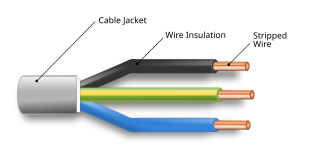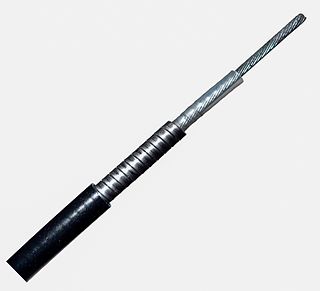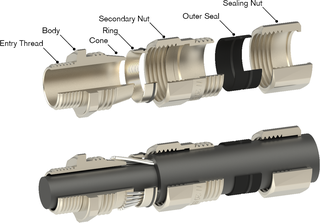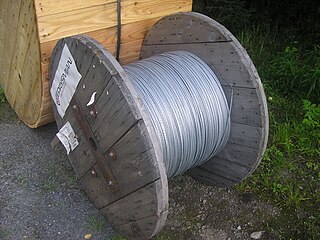 W
WAn electrical cable is an assembly of one or more wires running side by side or bundled, which is used to carry electric current.
 W
WBend radius, which is measured to the inside curvature, is the minimum radius one can bend a pipe, tube, sheet, cable or hose without kinking it, damaging it, or shortening its life. The smaller the bend radius, the greater is the material flexibility. The diagram to the right illustrates a cable with a seven-centimeter bend radius.
 W
WA Bowden cable is a type of flexible cable used to transmit mechanical force or energy by the movement of an inner cable relative to a hollow outer cable housing. The housing is generally of composite construction, consisting of an inner lining, a longitudinally incompressible layer such as a helical winding or a sheaf of steel wire, and a protective outer covering.
 W
WA braid is a complex structure or pattern formed by interlacing two or more strands of flexible material such as textile yarns, wire, or hair. Braids have been made for thousands of years, in many different cultures around the world, for a variety of uses.
 W
WCable carriers, also known as drag chains, energy chains, or cable chains depending on the manufacturer, are guides designed to surround and guide flexible electrical cables and hydraulic or pneumatic hoses connected to moving automated machinery. They reduce wear and stress on cables and hoses, prevent entanglement, and improve operator safety.
 W
WCable dressing ensures that electrical cables used in a telecommunications facility are neatly arranged. Cable ties, cable channels and cable lacing cord are used to accomplish this.
 W
WA cable gland is a device designed to attach and secure the end of an electrical cable to the equipment. A cable gland provides strain-relief and connects by a means suitable for the type and description of cable for which it is designed—including provision for making electrical connection to the armour or braid and lead or aluminium sheath of the cable, if any. Cable glands may also be used for sealing cables passing through bulkheads or gland plates. Cable glands are mostly used for cables with diameters between 1 mm and 75 mm.
 W
WA cable harness, also known as a wire harness, wiring harness, cable assembly, wiring assembly or wiring loom, is an assembly of electrical cables or wires which transmit signals or electrical power. The cables are bound together by a durable material such as rubber, vinyl, electrical tape, conduit, a weave of extruded string, or a combination thereof.
 W
WCircuit integrity refers to the operability of electrical circuits during a fire. It is a form of fire-resistance rating. Circuit integrity is achieved via passive fire protection means, which are subject to stringent listing and approval use and compliance.
 W
WDirect-buried cable (DBC) is a kind of communications or transmissions electrical cable which is especially designed to be buried under the ground without any kind of extra covering, sheathing, or piping to protect it.
 W
WDrawing is a metalworking process that uses tensile forces to stretch (elongate) metal, glass, or plastic. As the metal is drawn (pulled), it stretches to become thinner, to achieve a desired shape and thickness. Drawing is classified into two types: sheet metal drawing and wire, bar, and tube drawing. Sheet metal drawing is defined as plastic deformation over a curved axis. For wire, bar, and tube drawing, the starting stock is drawn through a die to reduce its diameter and increase its length. Drawing is usually performed at room temperature, thus classified a cold working process, however, drawing may also be performed at elevated temperatures to hot work large wires, rods or hollow sections in order to reduce forces.
 W
WAn electrical conduit is a tube used to protect and route electrical wiring in a building or structure. Electrical conduit may be made of metal, plastic, fiber, or fired clay. Most conduit is rigid, but flexible conduit is used for some purposes.
 W
WThe Nintendo Game Link Cable is an accessory for the Game Boy line of handheld video game systems, allowing players to connect Game Boys of all types for multiplayer gaming. Depending on the games, a Game Link Cable can be used to link two games of the same title, like Tetris, or two compatible games like Pokémon Red and Blue. Games can be linked for head-to-head competition, cooperative play, trading items, unlocking hidden features, etc.
 W
WCable management refers to management of electrical or optical cable in a cabinet or an installation. The term is used for products, workmanship or planning. Cables can easily become tangled, making them difficult to work with, sometimes resulting in devices accidentally becoming unplugged as one attempts to move a cable. Such cases are known as "cable spaghetti", any kind of problem diagnosis and future updates to such enclosures could be very difficult.
 W
WA messenger line or just messenger is relatively light cordage used to pull a heavier cable across a gap or through a tube or duct. The term is also used for a line used to pull or lower a package along a downline or jackstay.
 W
WA multicore cable is a type of electrical cable that combines multiple signals or power feeds into a single jacketed cable. The term is normally only used in relation to a cable that has more cores than commonly encountered. Not all cables with multiple insulated conductors are called multicore cables – the core in multicore refers to the number of usable connections made, not the number of conductors or wires. In most cases, a "usable connection" requires multiple conductors, such as the positive and negative conductors used for DC power.
 W
WA nicopress swaged sleeve is a mechanically swaged connector used to make a mechanical or electro-mechanical connection. These sleeves join or terminate: wire rope, aircraft cable, synthetic cable, fibrous rope, or electrical conductor/cable.
 W
WThe primary line constants are parameters that describe the characteristics of conductive transmission lines, such as pairs of copper wires, in terms of the physical electrical properties of the line. The primary line constants are only relevant to transmission lines and are to be contrasted with the secondary line constants, which can be derived from them, and are more generally applicable. The secondary line constants can be used, for instance, to compare the characteristics of a waveguide to a copper line, whereas the primary constants have no meaning for a waveguide.
 W
WRadio frequency power transmission is the transmission of the output power of a transmitter to an antenna. When the antenna is not situated close to the transmitter, special transmission lines are required.
 W
WA cable reel is a round, drum-shaped object such as a spool used to carry various types of electrical wires. Cable reels, which can also be termed as drums, have been used for many years to transport electric cables, fiber optic cables and wire products. Cable reels usually come in four different types, each with their own uses: wood, plywood, plastic and steel.
 W
WA talurit swaged sleeve is used in a mechanical splicing system, to make an eye splice in a steel wire rope. The most common and useful type of end fitting for a wire rope is to turn the end back to form a loop. A thimble can be installed inside the loop to preserve the natural shape of the loop and protect the cable from pinching and abrading on the inside of the loop. The loose end is then fixed back on the wire rope by means of a swaged sleeve (ferrule). The thimble prevents disrupting of the wires.The original T-ferrule design is the seamless aluminium ferrule, intended for galvanized or bright wire ropes. It corresponds to European standard, EN 13411-3. From size 8 and upwards fully traceable and marked with size, type and manufacturing batch number. The UM-ferrule is a cylindrical ferrule, smaller in diameter after pressing than the T-ferrule. The seamless ferrule made from carbon steel is aimed for bright and galvanized steel wire ropes. Using the same metals between rope and ferrule prevents electrolytic corrosion. They are intended for applications with high temperatures and/or abrasion, e.g. the steel melting and fishing industries. From size 8 and upwards they are fully traceable and marked with size and type. Ferrules made of copper and stainless steel. The round R-ferrule is intended to be pressed on single wire ropes, e.g. on preventer wires or used as end stop.
 W
WCable transport is a broad class of transport modes that have cables. They transport passengers and goods, often in vehicles called cable cars. The cable may be driven or passive, and items may be moved by pulling, sliding, sailing, or by drives within the object being moved on cableways. The use of pulleys and balancing of loads moving up and down are common elements of cable transport. They are often used in mountainous areas where cable haulage can overcome large differences in elevation.
 W
WAn umbilical cable or umbilical is a cable and/or hose that supplies required consumables to an apparatus, like a rocket, or to a person, such as a diver or astronaut. It is named by analogy with an umbilical cord. An umbilical can, for example, supply air and power to a pressure suit or hydraulic power, electrical power and fiber optics to subsea equipment and divers.
 W
WWire rope is several strands of metal wire twisted into a helix forming a composite rope, in a pattern known as laid rope. Larger diameter wire rope consists of multiple strands of such laid rope in a pattern known as cable laid.